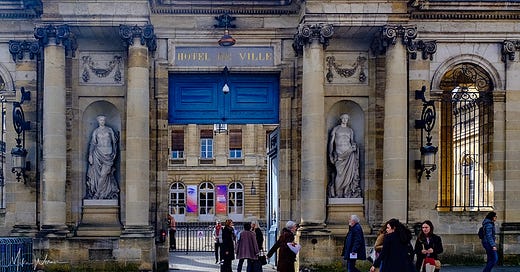This is Part 2 of 3 parts.
Click here to read Part 1.
Click here to read Part 3.You can also subscribe to our free newsletter delivered straight to your mailbox.
Palais Rohan
Palais Rohan, the city hall, is another splendid building, displaying French baroque architecture.
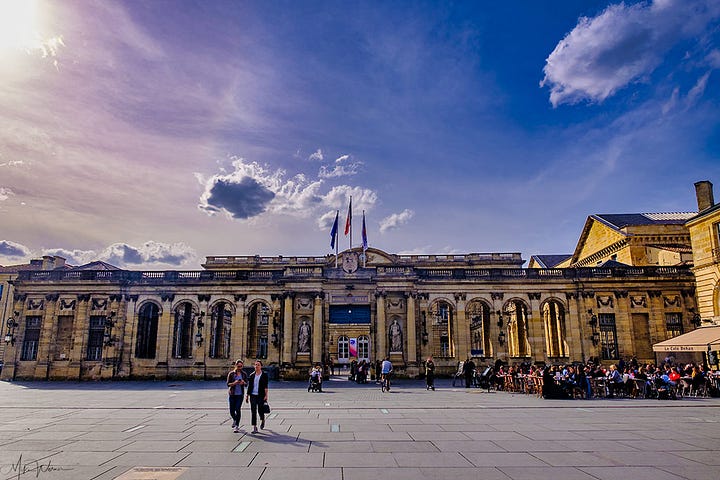
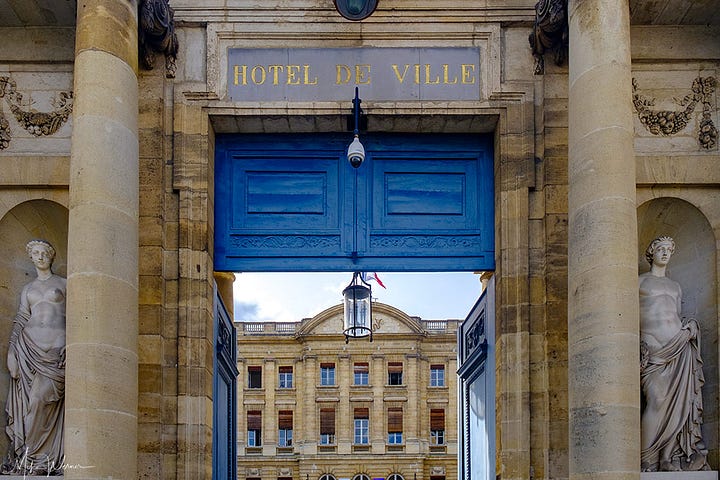
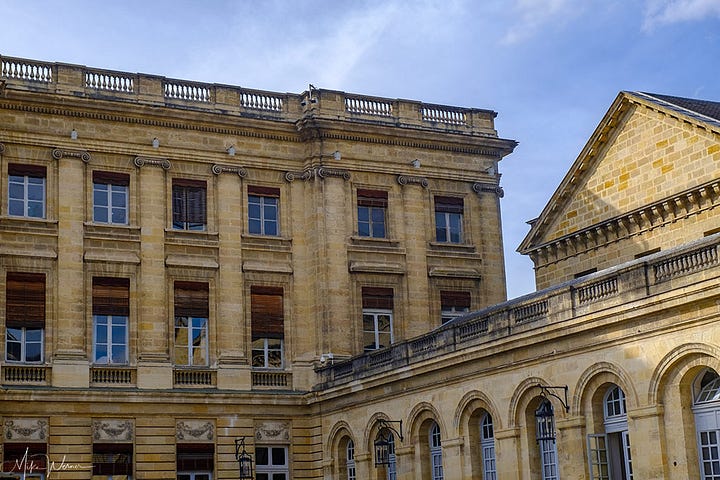
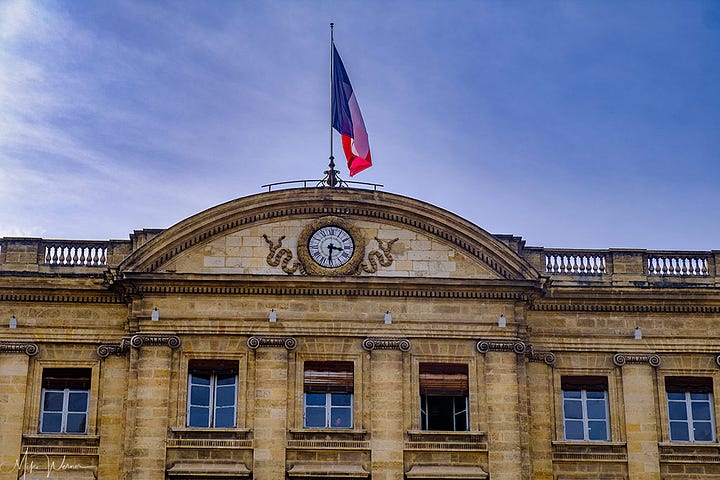
The Palais Rohan is one of the most important historical buildings in Bordeaux. Situated in the heart of the city, it currently serves as the City Hall (Hôtel de Ville). Its strategic location on Place Pey-Berland, adjacent to the Saint-André Cathedral, gives it a significant role in the city's civic and cultural landscape. The palatial edifice is a magnificent example of French classical architecture, showcasing elements of the Baroque style, characterized by its grandiosity, elaborate ornamentation, and balanced proportions.
The history of the Palais Rohan is a rich tapestry woven through various epochs of Bordeaux's past. It was originally built between 1771 and 1784 to serve as the residence for Ferdinand Maximilien Mériadec de Rohan, the Archbishop of Bordeaux at the time. The construction was undertaken by architect Joseph Etienne, who designed it in line with the 18th-century aesthetic sensibilities that reflected both opulence and elegance.
The Palais underwent several transformations over the years. During the French Revolution, it was confiscated as a national asset and was later converted into a courthouse. Eventually, it was designated as the City Hall in the 1830s. Throughout these changes, various renovations and restorations have been made to preserve its historical integrity while adapting it to its changing functions.
The interior of the Palais Rohan is as striking as its exterior. The grand staircase, with its intricate ironwork and sweeping balustrades, is a highlight. The rooms are adorned with chandeliers, gilded mirrors, and sumptuous tapestries, many of which have been restored to their original splendor. Some of these rooms are occasionally open to the public, often as part of heritage days or special guided tours, allowing visitors to glimpse the artistry and historical richness contained within its walls.
What's particularly interesting is how the Palais Rohan reflects Bordeaux's complex history. It stands as a testament to the city's religious significance during the time it was an archbishopric, its tumultuous journey through the Revolutionary era, and its eventual evolution into a modern civic center. The architecture itself—stately, harmonious, and grand—encapsulates the zeitgeist of the Age of Enlightenment, during which reason, art, and beauty were highly valued.
The square in front of the Palais, known as Place Pey-Berland, is also of note. This square is named after a former archbishop and is home to the Pey-Berland Tower, a Gothic bell tower that offers panoramic views of the city. The proximity of these important landmarks makes the area a focal point for tourists and locals alike, a place where the rich tapestry of Bordeaux's history, architecture, and civic life comes together.
Girondins Monument
The Monument aux Girondins, also known simply as the Girondins Monument, is a towering and evocative structure located at the western end of Esplanade des Quinconces in Bordeaux. This grand monument serves as a tribute to the Girondins, a political group during the French Revolution who advocated for a constitutional monarchy and were opposed to the radical Jacobin faction. Many members of the Girondins were arrested and executed in 1793 for their views, and this monument stands as an eloquent testament to their contributions and the ideals they stood for.
Designed by architect Victor Rich and sculptors Gustave Debrie and Achille Dumilâtre, the monument was erected between 1894 and 1902. The central feature is a towering column that rises to a height of 43 meters (141 feet), crowned with a statue representing Liberty breaking free from her chains. This column is surrounded by various sculptures, fountains, and bas-reliefs that provide both aesthetic appeal and historical context.

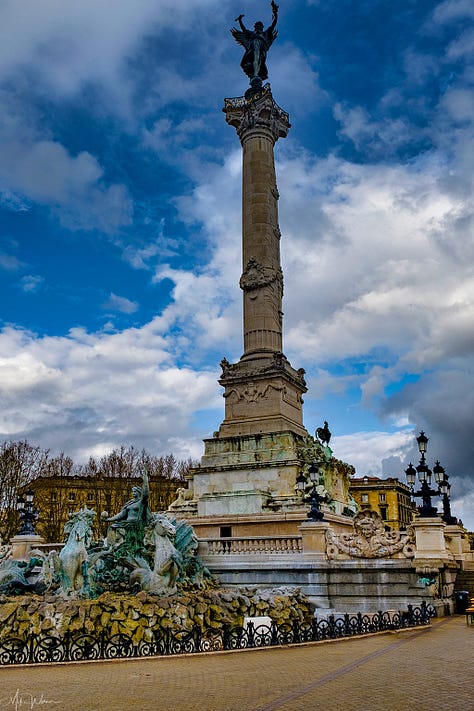
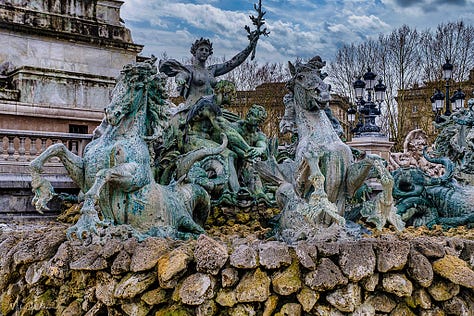
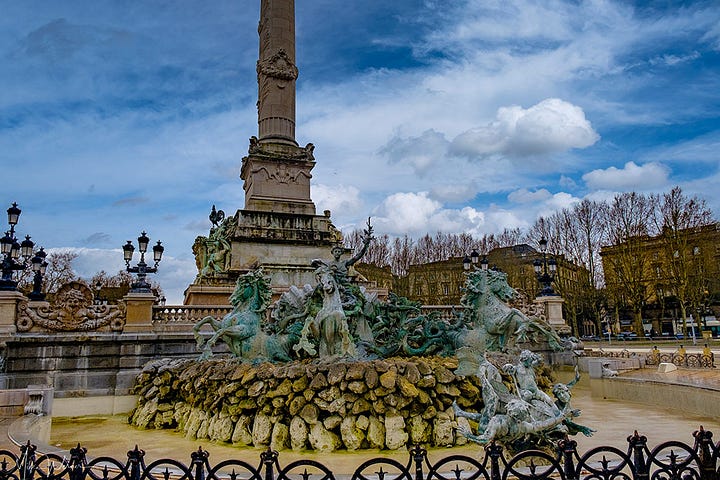
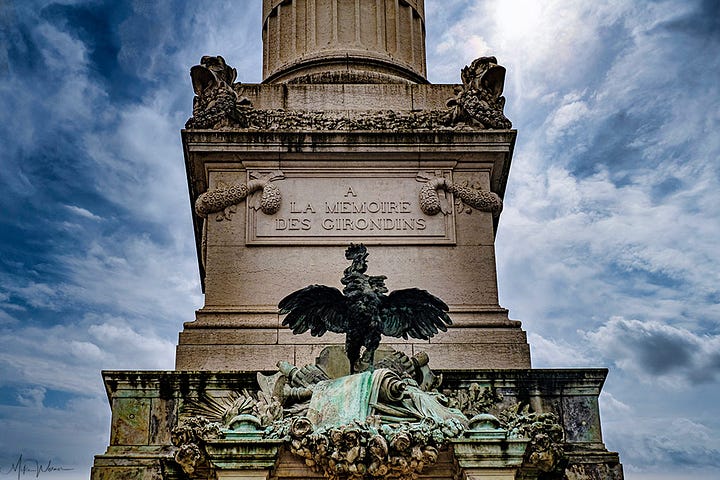
One of the most striking features of the monument is the two large fountains at its base, which are often referred to as the fountains of the Concorde. These fountains are adorned with bronze statues representing allegorical figures. On one side, you'll find figures that symbolize the triumph of the Republic; on the other, figures that represent the triumph of the Concorde (Unity). The statues are dynamic and expressive, capturing both human and animal forms in elaborate detail.
The water features add an additional layer of complexity and beauty to the monument. Cascading water and intricate fountain designs create a tranquil but powerful ambiance, making it a popular spot for reflection and photography. Various elements like seahorses, dolphins, and cornucopias are integrated into the fountains, symbolizing prosperity, vigilance, and the maritime spirit of Bordeaux.
The Monument aux Girondins is not just a historical or artistic landmark; it's also a central part of the social and cultural life of Bordeaux. The esplanade where it is situated, the Esplanade des Quinconces, is one of the largest squares in Europe and serves as a venue for various events, from fairs and circuses to political rallies and concerts. This makes the monument a gathering point, a place where the past and present converge, and where the ideals of liberty, unity, and republicanism continue to resonate.
Porte Cailhau
Porte Cailhau, or Cailhau Gate, is a remarkable historical gateway situated near the Place du Palais. Built in 1495, this medieval gate once served as one of the main entrances to the walled city and is now considered one of Bordeaux's most iconic landmarks. With its Gothic and Renaissance architectural elements, Porte Cailhau provides a tangible connection to Bordeaux's rich history, linking the present day to a past that saw kings and nobles pass through its arches.
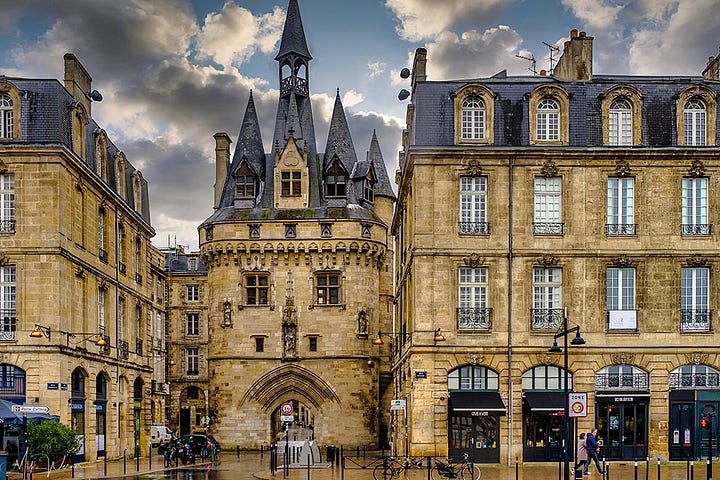
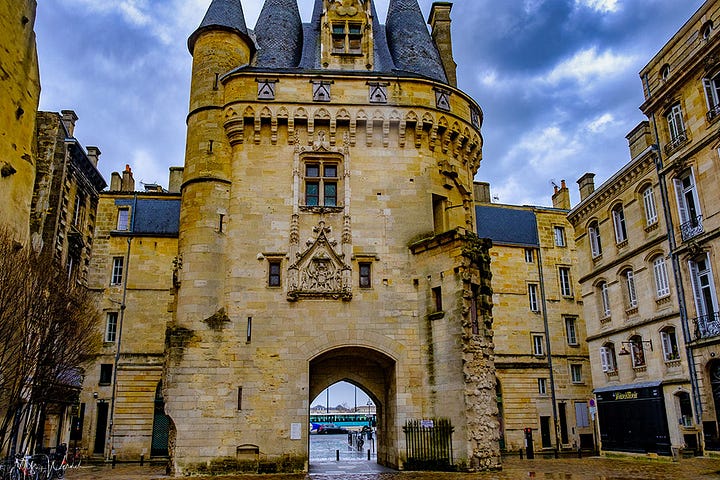

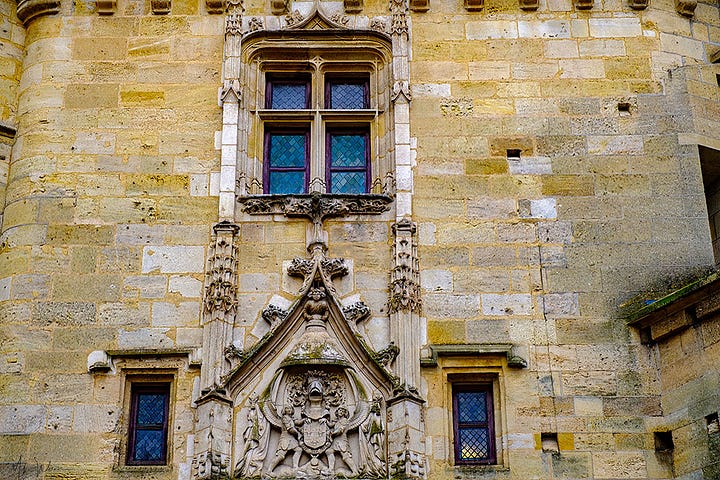
The gate was constructed to commemorate the victory of King Charles VIII at Fornovo, Italy, in 1495. The architectural style of Porte Cailhau blends military practicality with aesthetic grandeur, reflecting its dual role as both a defensive structure and a symbol of royal power. Standing at a height of about 35 meters (approximately 115 feet), the gate is built primarily from limestone, a material commonly found in the region and used in many of Bordeaux's historical buildings.
One of the striking features of Porte Cailhau is its tower, which is adorned with sculpted details such as fleurs-de-lis and the coat of arms of Bordeaux. These elements are indicative of the gate's royal associations and its importance as a symbol of the city's status. The structure incorporates both rounded and pointed arches, gargoyles, and ornamental sculptures that exhibit a mix of Gothic and Renaissance design features. The integration of these stylistic elements makes it a particularly interesting study for anyone interested in architecture or art history.
The interior of the gate offers equally fascinating insights. It has been transformed into a small museum, accessible via a staircase that winds its way to the upper levels. From the top, you can enjoy panoramic views of the surrounding cityscape, including the Garonne River and several nearby landmarks like the Grosse Cloche and the Palais Rohan. Historical exhibits within the gate provide further context, illuminating the structure's significance over the centuries.
In terms of its urban setting, Porte Cailhau is located near the historic district of Saint-Pierre, which is filled with narrow, winding streets and charming squares. Its proximity to the river and other notable sites makes it a strategic starting point for exploring Bordeaux's old town. The area around the gate is often bustling with activity, filled with both locals enjoying a casual stroll and tourists armed with cameras, all keen to capture the essence of this historic edifice.
Grosse Cloche
The Grosse Cloche, or "Big Bell," is one of Bordeaux's emblematic landmarks, steeped in history and local lore. Located between the Saint-Eloi and Saint-James streets in the historic heart of Bordeaux, this belfry is a vestige of medieval architecture and one of the oldest in France. The Grosse Cloche consists of two 40-meter-high towers connected by a central structure that houses the bell itself, making it a prominent fixture in the city's skyline.
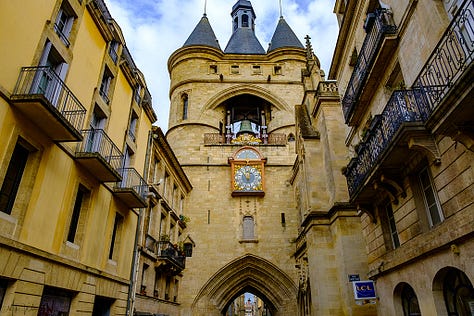
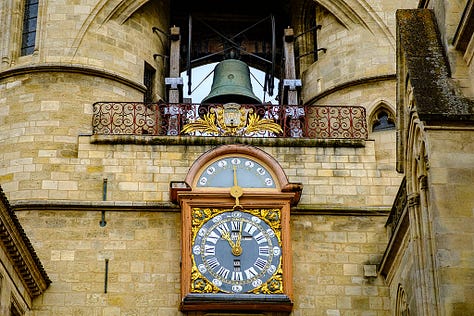
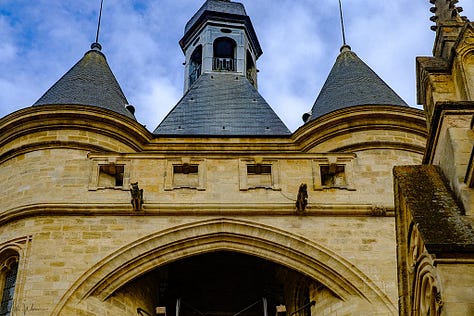


Constructed in the 13th century on the foundations of a 12th-century gate from the Gallo-Roman wall, the Grosse Cloche served multiple purposes throughout its history. Besides being a defensive gateway and belfry, it was once the town hall of Bordeaux and even served as a prison for some time. Given its various roles over the centuries, the Grosse Cloche has become a symbol of Bordeaux's civic authority and identity.
The bell within the tower weighs a staggering seven tons and is adorned with a Latin inscription that translates to "I toll for the law, for the people, and for the king." This encapsulates the bell's historical functions—announcing the opening and closing of the city gates, alerting citizens in cases of fires or other emergencies, and marking significant civic events or royal decrees. Due to its immense weight and the vibrations it produces, the bell is only rung on special occasions today, such as Bastille Day and New Year's Eve.
The architectural design of the Grosse Cloche is a fascinating blend of styles, indicative of the various epochs it has survived through. The twin towers exhibit Gothic architectural elements, while the central structure connecting them features a weather vane in the form of a golden leopard, a heraldic symbol associated with the English rule of Bordeaux during the Middle Ages. A clock with a moon phase indicator adorns the facade facing Saint-James street, adding another layer of complexity to this already multifaceted edifice.
Visiting the Grosse Cloche offers more than just an appreciation of its architectural merits. You can climb the towers to reach a viewing platform that offers panoramic vistas of Bordeaux's charming streets, terracotta rooftops, and the Garonne River. The towers also house small exhibitions detailing the history and significance of the structure, providing a deeper understanding of its role in the city's life over the centuries.
Porte de Bourgogne
The Porte de Bourgogne, or "Bordeaux Gate," is a monumental arch located at the convergence of the Cours Victor Hugo and the Palais Rohan. It marks the entrance to the city's historic center from the southern part of the city. The structure stands as a testament to Bordeaux's long history, having been designed and erected in the mid-18th century as part of the broader urban planning and beautification projects aimed at modernizing the city.

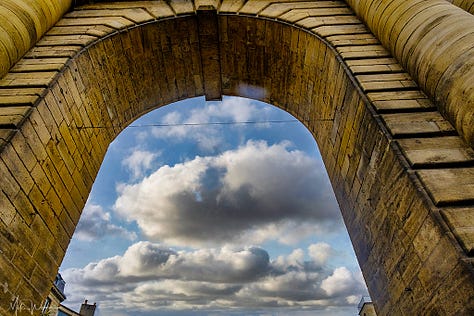
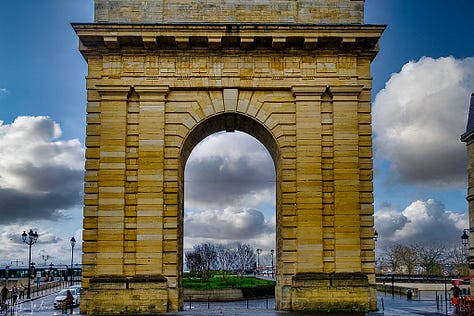
Architect André Portier is credited with the design of the Porte de Bourgogne, and its construction took place between 1750 and 1755. The arch was envisioned as a grandiose monument reflecting the growing importance of Bordeaux as a commercial and cultural hub. It replaced a medieval gate that had existed at the same location, part of the old fortifications that once encircled the city. The new arch was intended to symbolize not just the city's past but also its aspirations for the future.
The Porte de Bourgogne is constructed primarily out of limestone and features ornate carvings and sculptural elements that echo the classical architectural styles popular during the period. The design comprises a large central archway flanked by two smaller ones, framed by Corinthian columns and decorated pilasters. It is these details that provide the structure with its aesthetic richness and make it an intriguing example of the blending of architectural traditions, combining elements of both French and Italian classicism.
Atop the archway, you'll find an array of symbolic sculptures and carvings, including allegorical figures representing the Garonne River and the Dordogne River, both of which are vital waterways for Bordeaux. These figures symbolize the importance of maritime trade and commerce to the city's prosperity, a nod to Bordeaux's status as a major port city, especially famed for its wine trade.
The arch stands at the edge of the historic St. Pierre district, leading travelers and locals alike into a labyrinth of narrow streets and squares filled with historic landmarks, charming shops, and cafes. It's also situated quite close to the Place de la Bourse creating a harmonious continuity in the urban landscape.
Click here to read Part 1.
Click here to read Part 3.You can also subscribe to our free newsletter delivered straight to your mailbox.

